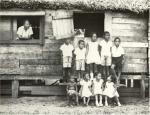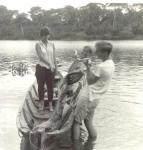 When he first arrived in Tortuguero, Costa Rica, Tom Carr was only five. He recalls that he tagged his first turtle when just six years old. He spent three years in Tortuguero with his parents before returning to the United States to go to school. Every summer for the next eighteen years he would return to help with the turtle project.
When he first arrived in Tortuguero, Costa Rica, Tom Carr was only five. He recalls that he tagged his first turtle when just six years old. He spent three years in Tortuguero with his parents before returning to the United States to go to school. Every summer for the next eighteen years he would return to help with the turtle project.
In the old days, the Tortuguero research station worked because it was one big family with the local village. The village helped the Carr family, and the Carr family helped them. “Pana pana hancome hango,” they would say. “You help us. We help you.”
The earliest settlers of Tortuguero were black Caribs. In the early days Carib faces were the only faces around, but through the years migration has brought an ethnic mix to the Tortuguero area. As they were generally the only people who could speak English, when the tourist boom began, many moved to San Jose and some became successful hoteliers, head chefs, and front deskmen.
At first, the Tortuguero field station was run just by Archie Carr, his family, and his graduate students from the University of Florida during the summers. There was very little communication or transportation, and one of the Carr boys would go down a week early to set up camp. As time went on Archie’s students who had graduated began to take over the project.
The early days of Tortuguero were filled with adventures straight from the pages of the Swiss Family Robinson, complete with smugglers, pirates, and guerrillas. Today, Tortuguero remains a colorful, albeit calmer, town.
Adventures in Tortuguero
Life in Tortuguero was not always easy nor quiet. There were little to no supplies. There were threats from Cuba and pirates. Here is one firsthand account of an adventure at Tortuguero.
Hunting the Giant Jewfish — recounted by Tom Carr
 To get fresh meat and quench my urge to fish the unknown waters of turtle bogue I would go fishing at the boca (river mouth) after my chores were done. I hooked a 400 pound Jewfish one late afternoon; I had tied the line to the largest log I could find on the sandbar at the mouth of the river. Even though he was in water only a meter deep he was able to pull me and the log slowly but surely into the sea. There were a hell of a lot of big tiger sharks out there in those days from all the turtle butchering going on.
To get fresh meat and quench my urge to fish the unknown waters of turtle bogue I would go fishing at the boca (river mouth) after my chores were done. I hooked a 400 pound Jewfish one late afternoon; I had tied the line to the largest log I could find on the sandbar at the mouth of the river. Even though he was in water only a meter deep he was able to pull me and the log slowly but surely into the sea. There were a hell of a lot of big tiger sharks out there in those days from all the turtle butchering going on.
At the last moment before the monster made it to deep water I got to my feet and ran out in to the water towards the fish using the line as my guide. As I ran I pulled a small .38 caliber derringer (a survival gun) from my back pocket, and when I reached the fish was able to shoot him twice in the head. The bullets did not enter the skull but the impact was such that that it stunned him and I was able to drag him back to shallow water. The fish was way to big for me to get him into my cayuca (canoe) so I tethered him to the gunwale and with a small outboard towed him back to Casa Verde (the Green House) where Shefton, our friend and cook, butchered him. The meat from this fish fed our team and the village for days. I was fourteen at the time.

Recent Comments